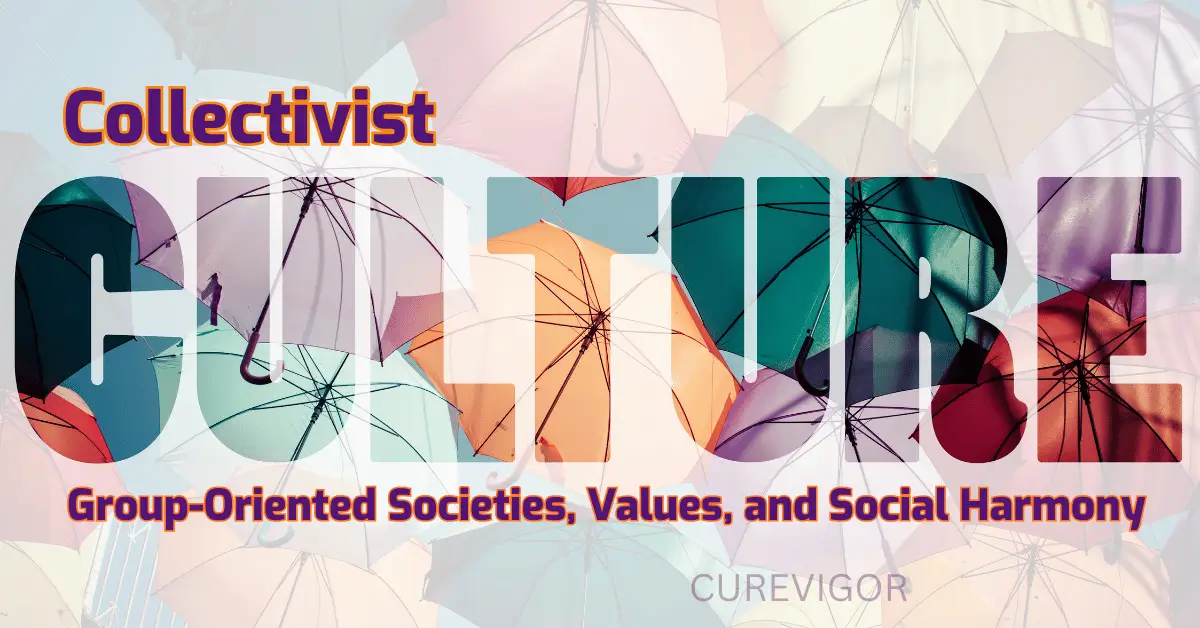Uncover the values that bind collectivist cultures — from family loyalty to social harmony. See why group-oriented societies still inspire global unity.
Thank you for reading this post, don't forget to subscribe!In a society where self-expression and individual achievement are becoming increasingly significant, some communities nevertheless have a completely different worldview that prioritizes togetherness over autonomy and shared well-being over individual ambition.
Collectivist Cultures: Understanding Group-Oriented Societies, Values, and Social Harmony
These are collectivist cultures, group-oriented societies where values of cooperation, respect, and social harmony form the foundation of life.
From family structure and education to leadership and conflict resolution, collectivism shapes how millions of people see their place in the world.
This guide examines how collectivist societies function, the mindset that underpins them, their core values, and their significance in a globalized world.
The Core Foundation: Defining the Collectivist Mindset

The ‘We’ Over ‘I’ Principle: Understanding the Psychological Shift from Individual Priority to Group Priority
At the heart of a collectivist culture lies a fundamental idea — that the individual is inseparable from the group. In these societies, identity comes not from personal achievements but from relationships, family roles, and community ties.
The “we” outweighs the “I,” creating a deep psychological orientation toward interdependence.
In collectivist thinking, self-interest aligns with group interest. A person succeeds when the community succeeds. This fosters emotional security and belonging, reducing isolation but also encouraging conformity.
The sense of shared destiny builds resilience during challenges, as people feel responsible for one another’s well-being. This unity is what sustains social harmony, especially in times of crisis.
Distinctions from Individualistic Societies: Key Differences in Decision-Making, Blame, and Identity
Collectivist societies differ sharply from individualistic ones — not in intelligence or ambition, but in how people define success, make choices, and understand morality.
In individualistic cultures (like the U.S. or Western Europe), personal choice and independence are sacred. People take pride in standing out, challenging authority, and pursuing unique goals.
Decisions are typically made through consultation or consensus, not individual assertion. When mistakes occur, blame is shared because outcomes reflect the group’s collective effort.
Identity, too, is communal: a person is “a son of,” “a member of,” or “part of” a wider whole. This difference is not a limitation but rather a way of maintaining stability and mutual care within societies that prioritize continuity over competition.
The Psychology and Social Impact of Group-Oriented Norms
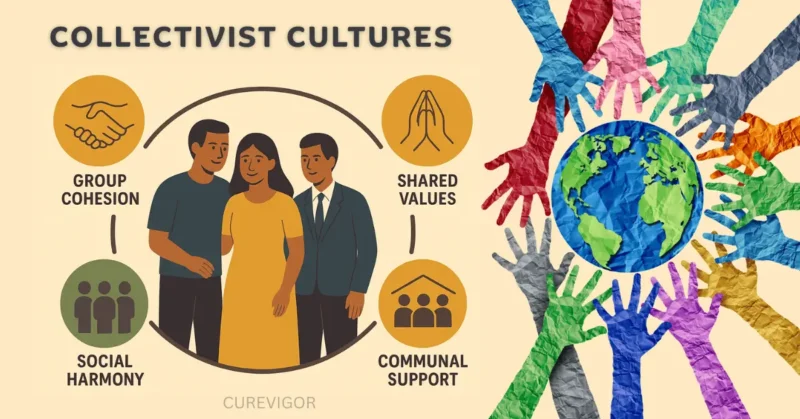
Collectivist norms cultivate empathy, cooperation, and emotional intelligence from an early age. People learn to recognize subtle social cues and avoid conflict—crucial traits in preserving harmony within close-knit groups.
Collectivism fosters resilience psychologically. During difficult times, people find strength in a large support system. Shared obligations for caring for the elderly, raising children, and providing community assistance lessen social isolation and stress.
However, collectivism also presents challenges. Strong in-group loyalty can lead to in-group bias, where outsiders are viewed with suspicion. The pressure to conform can limit personal expression or innovation.
Yet, when balanced, these societies achieve a rare stability: a collective moral compass that binds generations together under shared values and social harmony.
Pillars of Social Harmony: The Cultural Components of Peace
Collectivist societies are built upon enduring principles that preserve unity. Individuals are woven into a cohesive social fabric by these values, which function as unseen threads.
Dignity and Mutual Respect as the Social Glue
Dignity and Mutual Respect: A Powerful Mindful Approach to Harmony and Inner Peace
Respect in collectivist cultures isn’t something earned — it’s inherent. Every person, regardless of age, gender, or class, is treated with dignity simply because they are part of the community.
This unspoken understanding ensures smooth relationships. Elders are honored not for power but for wisdom; youth are guided, not dismissed.
Respect becomes the social glue that holds society together, reducing conflict and ensuring that communication stays considerate.
By emphasizing inherent dignity, collectivist values make social harmony more than a goal — they make it a daily practice, seen in greetings, gestures, and even the tone of speech.
The Role of Character, Education, and Spirituality
Character formation in collectivist societies isn’t left to chance. It’s built through family teachings, religious traditions, and educational systems that stress moral responsibility. Children learn early that their actions reflect on the entire family.
Education extends beyond academics — it includes lessons on respect, empathy, and social duty. Spiritual beliefs reinforce these ideas, connecting individual conduct with cosmic order or divine balance.
Through this integration of faith, knowledge, and shared ethics, collectivist societies nurture citizens who see service as strength and unity as virtue — essential traits for maintaining values and social harmony across generations.
Unifying Values and Shared Morality
Shared morality is the ethical backbone of collectivist societies. Principles like honesty, humility, and self-restraint aren’t abstract ideals; they’re daily expectations guiding interpersonal behavior.
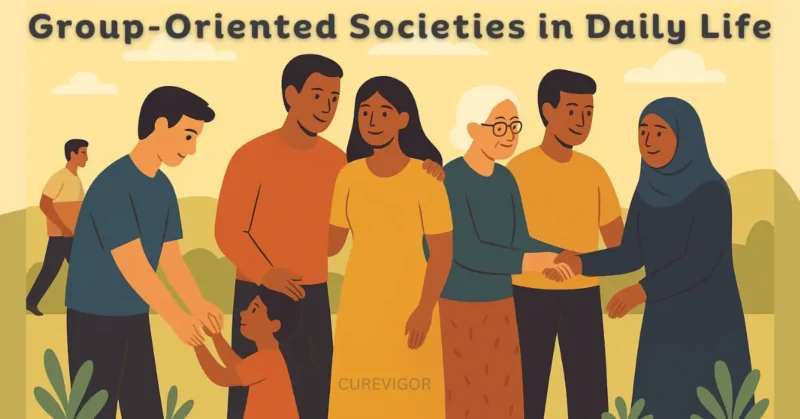
These shared values foster trust. When everyone plays by the same moral rules, social life becomes predictable and safe. Collective rituals, festivals, and moral codes enhance social belonging, making morality a shared aspect of the community rather than just a personal one.
Such harmony-oriented ethics create a steady rhythm in these societies, where cooperation feels natural and community stability is regarded as the highest moral achievement.
Traditional Institutions: Maintaining Order and Collective Well-being
Collectivist societies prosper due to structures that maintain unity and resolve conflicts peacefully. Traditional institutions, often led by elders or councils, serve as moral anchors and social regulators.
Conflict Resolution and Moral Guidance from Traditional Institutions
In collectivist communities, justice seeks restoration, not punishment. When disputes arise, elders or councils mediate through dialogue, storytelling, and mutual understanding. Their goal is not to assign blame but to heal relationships.
These traditional institutions carry deep legitimacy. People trust them because they embody lived wisdom and shared cultural values. Their authority lies in consensus, not coercion.
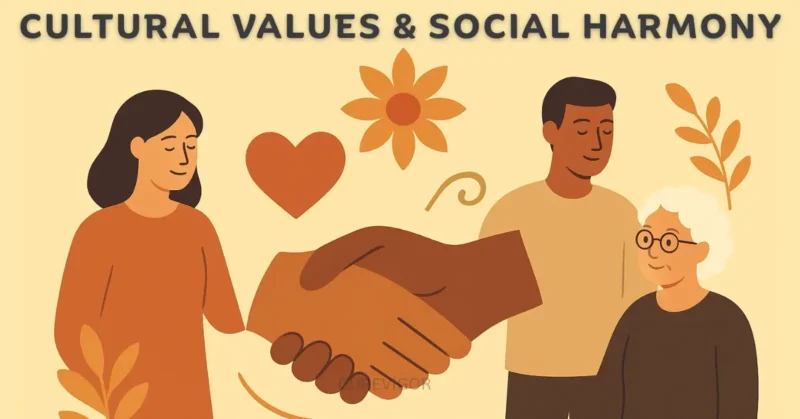
By addressing conflict through empathy and reconciliation, these institutions foster social harmony, ensuring that even disagreements strengthen the community rather than divide it.
Governance and Consensus in Community-Led Societies
How Community-Oriented Cultures Lead with Consensus and Rotational Leadership
In collectivist governance models, leadership is service, not status. Decisions emerge from lengthy discussions aimed at finding balance. Councils or assemblies listen to every voice until a common path emerges — a consensus that reflects the collective will.
This rotational or shared leadership prevents domination and encourages humility. Leaders are often chosen for wisdom and fairness, not ambition. Governance becomes a community duty rather than a political contest.
Such systems reinforce mutual respect and accountability — vital values that protect social harmony and empower citizens to feel ownership of their society’s direction.
Collectivist Cultures Life in Practice: Family and Professional Dynamics
Collectivism isn’t just a philosophy — it’s a way of life shaping family, work, and communication.
The Importance of Kinship and the Extended Family
Family is the nucleus of collectivist societies. The concept extends beyond the nuclear household to include grandparents, cousins, uncles, and even neighbors who share emotional and economic bonds.

This network offers stability in uncertain times. Responsibilities and resources are shared, ensuring no one is left behind. Children learn respect and duty by observing intergenerational cooperation.
Such kinship systems make the family a miniature model of the wider society — interdependent, resilient, and centered on mutual care — the living proof of social harmony in action.
Communication Characteristics in High-Context Cultures
Collectivist societies are known for high-context communication — a style that values subtlety, tone, and shared understanding over direct speech.
People often express disagreement indirectly, preserving others’ dignity. Silence, gestures, and facial expressions carry as much meaning as words. This delicate form of interaction prevents embarrassment and keeps relationships intact.
By prioritizing emotional sensitivity, collectivist communication preserves peace and shows that the greatest respect sometimes lies not in what is said, but in what is gently implied.
Work and Education in Group-Oriented Cultures
In collectivist workplaces and schools, success is measured by collective achievement. Teams are valued over individuals, and loyalty is highly prized.
Workers see their job not just as employment but as a contribution to a larger mission. In education, cooperation replaces competition; helping a peer is a sign of strength, not weakness.
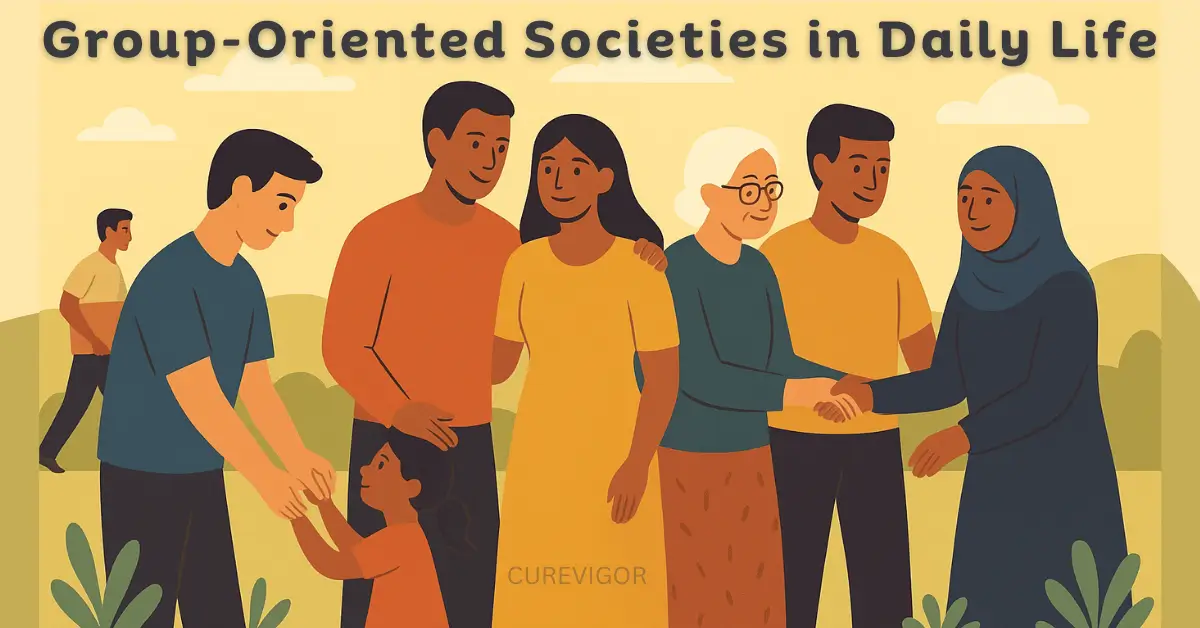
This creates institutions where trust thrives, and every person feels accountable to others — a social structure that continually reinforces values and societal harmony through shared effort.
Global Context: Collectivism in a Globalized World
Where Collectivism Thrives Today
Collectivist cultures flourish across Asia (China, Japan, Korea), Africa (Nigeria, Kenya, Ghana), Latin America (Mexico, Colombia), and the Middle East. Despite differences in religion or language, they share an emphasis on family, hierarchy, and community welfare.
In these regions, the idea of “one for all” isn’t just moral—it’s practical. Economic cooperation, social safety nets, and neighborhood trust remain strong. This interconnectedness has kept these societies resilient even in modern times.
Modern Transitions: The Impact of Globalization and Technology
Globalization has challenged traditional collectivist norms. Technology, urbanization, and Western media often promote individuality and self-branding. Younger generations in collectivist societies now juggle two worlds — traditional duty and digital self-expression.
Yet, instead of collapsing, collectivism adapts. Online communities mirror village networks, and modern leaders draw on cultural roots to promote teamwork and empathy. The evolving balance between “we” and “I” is shaping new models of social harmony in the digital age.
Frequently Asked Questions (FAQs) on Collectivist Cultures
Q: Are collectivist cultures more resistant to stress?
Yes, collectivist cultures tend to handle stress more effectively because emotional support is built into the social structure. Individuals rarely face problems alone — families, neighbors, or colleagues step in to share the burden.
This sense of belonging cushions emotional strain, improving resilience and overall well-being. While personal expression of stress may be subdued to maintain harmony, the community-based coping system makes these societies remarkably strong under pressure.
Q: How does collective identity impact mental health?
Collective identity offers psychological security by grounding individuals in shared meaning and belonging. People know who they are and where they fit, reducing anxiety and alienation.
Mutual care and empathy further enhance emotional stability. However, excessive conformity or social judgment can create pressure. When balanced, collective identity strengthens mental health by fostering connection and purpose — two cornerstones of emotional resilience.
Q: Can individualism and collectivism coexist in one workplace?
Yes, and many modern organizations successfully blend the two. Workplaces that combine individual creativity with collectivist teamwork achieve both innovation and stability.
Employees are encouraged to share their ideas, ensuring they align with our shared goals. This hybrid culture fosters trust, productivity, and inclusion, demonstrating that collaboration and autonomy can complement each other, leading to sustainable social harmony.
Q: Do collectivist societies limit personal freedom?
While collectivist cultures emphasize group needs, they don’t necessarily suppress individuality. Instead, they redefine freedom as living responsibly within relationships.
Boundaries are set to protect the group’s balance, not to restrict personal happiness. Many find fulfillment in contributing to a greater purpose. True freedom, in this view, is about connection — being part of something that transcends the self.
Q: What are some modern examples of collectivist principles in action?
Examples include community-based disaster response in Japan, extended family networks in India and Africa, and cooperative business models in Latin America.
These systems prioritize mutual aid over profit and empathy over rivalry. Even in urban environments, collective initiatives such as shared childcare or neighborhood watch programs show how societies continue to draw strength from collectivist values.
Q: How can individualistic cultures learn from collectivist societies?
Individualistic cultures can learn to emphasize empathy, shared responsibility, and relational awareness. Incorporating collective principles can counter loneliness and social fragmentation common in highly independent societies.
Practices such as community volunteering, consensus-building, and respect for elders create balance by combining personal ambition with communal care, enhancing social harmony and sustainable growth.
Conclusion: The Enduring Relevance of Collective Well-being
In the modern age of self-promotion and digital isolation, collectivist cultures remind us that true progress depends on connection. Their focus on shared values, respect, and social harmony offers lessons the world urgently needs — that peace begins not with power, but with people.
From the extended family to national governance, collectivist societies show that unity isn’t the absence of individuality but the alignment of many hearts toward one purpose: collective well-being.
As we navigate globalization, the wisdom of these cultures remains timeless, reminding us that humanity thrives best when we come together.
Read more on Health and Wellness Tips.
You might like to read:

